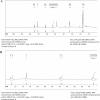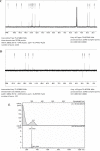Antineoplastic Activity Evaluation of Brazilian Brown Propolis and Artepillin C in Colorectal Area of Wistar Rats
- PMID: 38415543
- PMCID: PMC11077124
- DOI: 10.31557/APJCP.2024.25.2.563
Antineoplastic Activity Evaluation of Brazilian Brown Propolis and Artepillin C in Colorectal Area of Wistar Rats
Abstract
Objective: The study's aim was to evaluate Brazilian Brown Propolis (BBP) and Artepillin C (ARC) chemopreventive action in Wistar rats' colons.
Methods: Fifty male Wistar rats were divided into ten experimental groups, including control groups, groups with and without 1,2-dimethylhydrazine (DMH) induction, and BBP, ARC, and ARC enriched fraction (EFR) treatments, for sixteen weeks. Aberrant crypt foci (ACF) were classified as hyperplastic or dysplastic, and proliferating cell nuclear antigen (PCNA) expression was quantified.
Result: ACF amounts in experimental groups (induced or not) decreased in both colon portions, while the isolated Aberrant Crypt (AC) number increased. Experimental groups of animals showed higher hyperplasia and dysplasia amounts compared with control groups. The ACF dysplastic amount present in groups induced and treated, in both colon portions, had similar values to IDMH (DMH induction group without treatment). In addition, DMH was effective in ACF inducing and there was positive staining for PCNA in basal and upper dysplastic foci portions in all experimental groups, in the mitotic index (MI) evaluation. To conclude, considering all the experimental groups, the one treated with EFR (fraction enriched with ARC) had the lowest rates of cell proliferation.
Conclusion: BBP and its derivatives prevented crypt cell clonal expansion.
Keywords: 1; 2-DIMETHYLHYDRAZINE (DMH); BRAZILIAN BROWN PROPOLIS (BBP); Chemoprevention; aberrant crypt foci (ACF).
Conflict of interest statement
The authors have no financial or proprietary interests in any material discussed in this article.
Figures








Similar articles
-
Probiotic Dahi containing Lactobacillus acidophilus and Bifidobacterium bifidum modulates the formation of aberrant crypt foci, mucin-depleted foci, and cell proliferation on 1,2-dimethylhydrazine-induced colorectal carcinogenesis in Wistar rats.Rejuvenation Res. 2014 Aug;17(4):325-33. doi: 10.1089/rej.2013.1537. Rejuvenation Res. 2014. PMID: 24524423
-
Evaluation of Antineoplasic Activity of Zingiber Officinale Essential Oil in the Colorectal Region of Wistar Rats.Asian Pac J Cancer Prev. 2020 Jul 1;21(7):2141-2147. doi: 10.31557/APJCP.2020.21.7.2141. Asian Pac J Cancer Prev. 2020. PMID: 32711443 Free PMC article.
-
Asiatic acid abridges pre-neoplastic lesions, inflammation, cell proliferation and induces apoptosis in a rat model of colon carcinogenesis.Chem Biol Interact. 2017 Dec 25;278:197-211. doi: 10.1016/j.cbi.2017.10.024. Epub 2017 Nov 6. Chem Biol Interact. 2017. PMID: 29108773
-
Lack of chemoprevention of dietary Agaricus blazei against rat colonic aberrant crypt foci.Hum Exp Toxicol. 2008 Jun;27(6):505-11. doi: 10.1177/0960327108091862. Hum Exp Toxicol. 2008. PMID: 18784204
-
Chemopreventive effect of Amorphophallus campanulatus (Roxb.) blume tuber against aberrant crypt foci and cell proliferation in 1, 2-dimethylhydrazine induced colon carcinogenesis.Asian Pac J Cancer Prev. 2013;14(9):5331-9. doi: 10.7314/apjcp.2013.14.9.5331. Asian Pac J Cancer Prev. 2013. PMID: 24175821
Cited by
-
Therapeutic efficacy of brown propolis from Araucaria sp. in modulating rheumatoid arthritis.Inflammopharmacology. 2025 Feb;33(2):799-807. doi: 10.1007/s10787-024-01589-7. Epub 2024 Nov 25. Inflammopharmacology. 2025. PMID: 39586939
-
Polyphenols in the Prevention and Treatment of Colorectal Cancer: A Systematic Review of Clinical Evidence.Nutrients. 2024 Aug 16;16(16):2735. doi: 10.3390/nu16162735. Nutrients. 2024. PMID: 39203871 Free PMC article.
References
-
- Eser S, Chang J, Charalambous H, Silverman B, Demetriou A, Yakut C, et al. Incidence patterns of colorectal cancers in four countries of the middle east cancer consortium (cyprus, jordan, israel, and İzmir, turkey) compared with those in the united states surveillance, epidemiology, and end results program. Turk J Gastroenterol. 2018;29(1):36–44. - PMC - PubMed
-
- Moati E, Taly V, Didelot A, Perkins G, Blons H, Taieb J, et al. Role of circulating tumor DNA in the management of patients with colorectal cancer. Clin Res Hepatol Gastroenterol. 2018;42(5):396–402. - PubMed
-
- Valadao M, LS C. Hereditary colorectal cancer. Rev Col Bras Cir. 2018;34:193–40.
-
- Ganaie MA, Al Saeedan A, Madhkali H, Jan BL, Khatlani T, Sheikh IA, et al. Chemopreventive efficacy zingerone (4-[4-hydroxy-3-methylphenyl] butan-2-one) in experimental colon carcinogenesis in wistar rats. Environ Toxicol. 2019;34(5):610–25. - PubMed
MeSH terms
Substances
LinkOut - more resources
Full Text Sources
Miscellaneous

